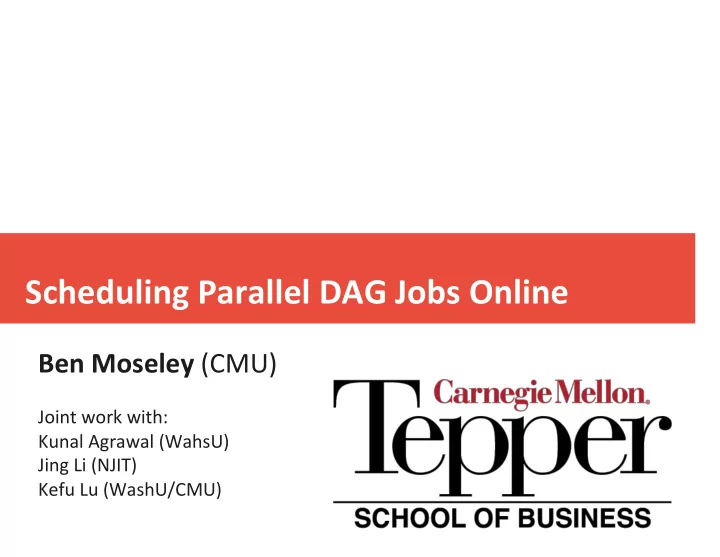

Scheduling Parallel DAG Jobs Online Ben Moseley (CMU) Joint work with: Kunal Agrawal (WahsU) Jing Li (NJIT) Kefu Lu (WashU/CMU)
Client-Server Scheduling l Clients send parallel jobs to the server l Jobs schedule on identical processors/machines l Server processes jobs and provides service guarantees l Jobs arrive over time – online l Jobs can be preempted l Worst case setting 2
Service Guarantees • Flow time – difference between arrival and completion of a job • Common objectives in online scheduling: • Average/Sum Flow Time • Maximum Flow Time • Throughput Time Job's Flow Time Arrival Completion 3
Parallelism Models • Speed-up Curves • Jobs associated with speed-up functions • Directed-Acyclic Graph (DAG) Model • Jobs have work which correspond to a DAG • Each job is modeled as a DAG • Job completed when last node of its DAG is completed • Processing rate depends on the number of nodes being worked on 4
Parallelism Models • Speed-Up Curves l Jobs have total work W divided into phases l Each phase has work l Phases are processed sequentially l Processing rate function Γ (m) l Function of number of processors given l Function is usually positive sub-linear l Function can be different depending on the phase the job is currently in. A Job's Phases 5
Directed Acyclic Graph Model of Parallelism l Nodes represent computation l Arrows represent dependencies 6
Online Study of Models • DAG model • Well-studied offline • Only studied recently online • Naturally captures programs generated by languages and libraries such as Cilk, Cilk Plus, Intel TBB, OpenMP. • Used by applied communities: Cyber-Physical-Systems (Real-Time) community excited (Outstanding paper award ECTRS 2013, Best- Student-Paper Award RTSS 2011) 7
Results First results for average flow in DAG model Average Flow Time [SODA 2016] • LAPS is (1+ ε ) speed O (1) competitive, for fixed ε >0 • Best theoretically possible Throughput [LATIN 2018] • A (1+ ε ) speed O (1) competitive algorithm for fixed ε >0 • Best theoretically possible Maximum Flow time [SPAA 2016] • A (1+ ε ) speed O (1) competitive algorithm, for fixed ε >0 • Open if speed is needed • Algorithm is practical
Algortihm Development • DAG model has been popular because of its connection to practice • Well studied for scheduling a single DAG job to minimize makespan • Work stealing algorithm: good practical and theoretical performance • Used in numerous systems for scheduling a parallel job • Non-clairvoyant • Distributed protocol • No preemption • Want to emulate this success and use theory for FIFO to guide a modification of Work- Stealing
Work-Stealing push Core 1 Steal Core 2 pop Core 3 double ended queues
Example: FIFO FIFO: Execute available nodes of job(s) with earliest arrival Could be more than one job depending on ready nodes
FIFO: Implementation Challenges Job 1 arrives at time 0 Job 2 arrives at time 1 Core 1 Core 2 Core 3
FIFO: Implementation Challenges A global queue Q Job 1 storing all available nodes arrives at time 0 Job 2 arrives at time 1 Core 1 Core 2 Q Core 3 Time 0 1 2 3 4 5 6
FIFO: Implementation Challenges A global queue Q Job 1 storing all available nodes arrives at time 0 Job 2 arrives at time 1 Core 1 Job’s arrival time 0 0 0 1 Core 2 Q Core 3 Time 0 1 2 3 4 5 6
FIFO: Implementation Challenges A global queue Q Job 1 storing all available nodes arrives at time 0 Each core at each time step executes one node in Q Job 2 from the job with the arrives at earliest arrival time time 1 Core 1 Job’s arrival time 0 0 0 1 Core 2 Q Core 3 Time 0 1 2 3 4 5 6
FIFO: Implementation Challenges A global queue Q Job 1 storing all available nodes arrives at time 0 Each core at each time step executes one node in Q Job 2 from the job with the arrives at earliest arrival time time 1 Core 1 Job’s arrival time 1 0 Core 2 Q Core 3 Time 0 1 2 3 4 5 6
Work Stealing for Multiple jobs Cores 1 execute FIFO order Parallel jobs C B 2 arrive at global queue admit 3 steal (1) Each core has a queue and executes work from it (2) Only when the local queue runs out of work, a core will admit a job from global queue (3) Algorithm can steal for other queues or from the global queue Has the same theoretical guarantees as FIFO and gave good practical performance
Conclusion New results for scheduling DAG jobs online • Results have lead to practically usable algorithms for minimizing • maximum flow time Recent results submitted for average flow time • • Much harder due to the need for preemptions Open Questions: • • Is resource augmentation needed for maximum flow time in the DAG and speed up curve model (knowing parallelism)? • Practical algorithm for throughput maximization?
Thank You! Questions? 0.14 0.09 0.1 Bing workload Finance workload Log-normal workload 0.09 0.08 0.12 OPT OPT 0.08 0.07 OPT steal-k-first steal-k-first 0.1 0.07 Max flow time (sec) Max flow time (sec) Max flow time (sec) steal-k-first 0.06 admit-first admit-first 0.06 admit-first 0.08 0.05 0.05 0.04 0.06 0.04 0.03 0.03 0.04 0.02 0.02 0.02 0.01 0.01 0 0 0 800 1000 1200 800 900 1000 800 1000 1200 QPS QPS QPS (a) Bing workload (b) Finance workload (c) Log-normal workload 19
Recommend
More recommend